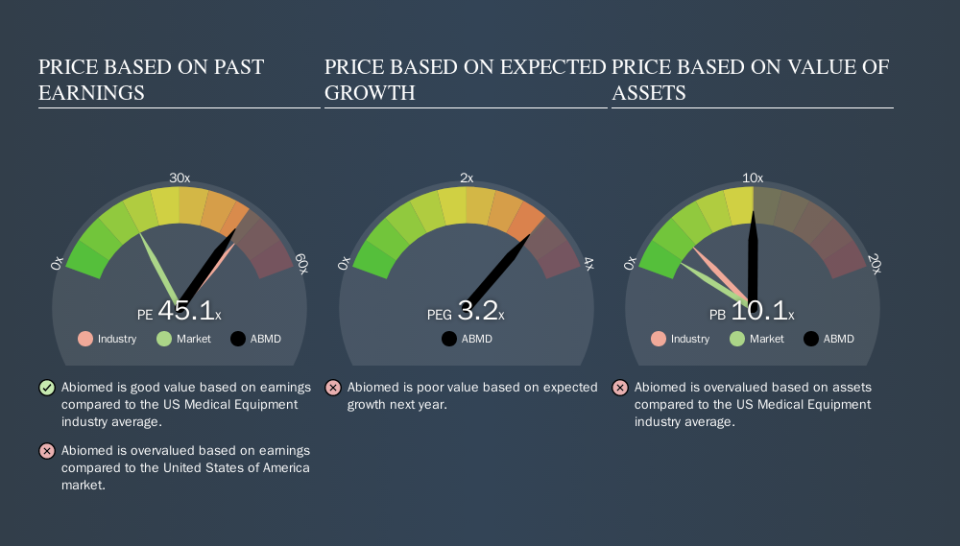What Is Abiomed's (NASDAQ:ABMD) P/E Ratio After Its Share Price Rocketed?

Abiomed (NASDAQ:ABMD) shareholders are no doubt pleased to see that the share price has had a great month, posting a 30% gain, recovering from prior weakness. But shareholders may not all be feeling jubilant, since the share price is still down 44% in the last year.
All else being equal, a sharp share price increase should make a stock less attractive to potential investors. While the market sentiment towards a stock is very changeable, in the long run, the share price will tend to move in the same direction as earnings per share. The implication here is that deep value investors might steer clear when expectations of a company are too high. One way to gauge market expectations of a stock is to look at its Price to Earnings Ratio (PE Ratio). Investors have optimistic expectations of companies with higher P/E ratios, compared to companies with lower P/E ratios.
See our latest analysis for Abiomed
How Does Abiomed's P/E Ratio Compare To Its Peers?
Abiomed has a P/E ratio of 45.09. As you can see below Abiomed has a P/E ratio that is fairly close for the average for the medical equipment industry, which is 46.3.
Its P/E ratio suggests that Abiomed shareholders think that in the future it will perform about the same as other companies in its industry classification. So if Abiomed actually outperforms its peers going forward, that should be a positive for the share price. Further research into factors such as insider buying and selling, could help you form your own view on whether that is likely.
How Growth Rates Impact P/E Ratios
Generally speaking the rate of earnings growth has a profound impact on a company's P/E multiple. When earnings grow, the 'E' increases, over time. That means unless the share price increases, the P/E will reduce in a few years. And as that P/E ratio drops, the company will look cheap, unless its share price increases.
It's great to see that Abiomed grew EPS by 14% in the last year. And it has bolstered its earnings per share by 81% per year over the last five years. With that performance, you might expect an above average P/E ratio.
Remember: P/E Ratios Don't Consider The Balance Sheet
Don't forget that the P/E ratio considers market capitalization. So it won't reflect the advantage of cash, or disadvantage of debt. Theoretically, a business can improve its earnings (and produce a lower P/E in the future) by investing in growth. That means taking on debt (or spending its cash).
While growth expenditure doesn't always pay off, the point is that it is a good option to have; but one that the P/E ratio ignores.
Is Debt Impacting Abiomed's P/E?
The extra options and safety that comes with Abiomed's US$445m net cash position means that it deserves a higher P/E than it would if it had a lot of net debt.
The Verdict On Abiomed's P/E Ratio
Abiomed has a P/E of 45.1. That's higher than the average in its market, which is 18.2. With cash in the bank the company has plenty of growth options -- and it is already on the right track. So it does not seem strange that the P/E is above average. What we know for sure is that investors have become much more excited about Abiomed recently, since they have pushed its P/E ratio from 34.6 to 45.1 over the last month. If you like to buy stocks that have recently impressed the market, then this one might be a candidate; but if you prefer to invest when there is 'blood in the streets', then you may feel the opportunity has passed.
When the market is wrong about a stock, it gives savvy investors an opportunity. If the reality for a company is better than it expects, you can make money by buying and holding for the long term. So this free visualization of the analyst consensus on future earnings could help you make the right decision about whether to buy, sell, or hold.
But note: Abiomed may not be the best stock to buy. So take a peek at this free list of interesting companies with strong recent earnings growth (and a P/E ratio below 20).
We aim to bring you long-term focused research analysis driven by fundamental data. Note that our analysis may not factor in the latest price-sensitive company announcements or qualitative material.
If you spot an error that warrants correction, please contact the editor at editorial-team@simplywallst.com. This article by Simply Wall St is general in nature. It does not constitute a recommendation to buy or sell any stock, and does not take account of your objectives, or your financial situation. Simply Wall St has no position in the stocks mentioned. Thank you for reading.

